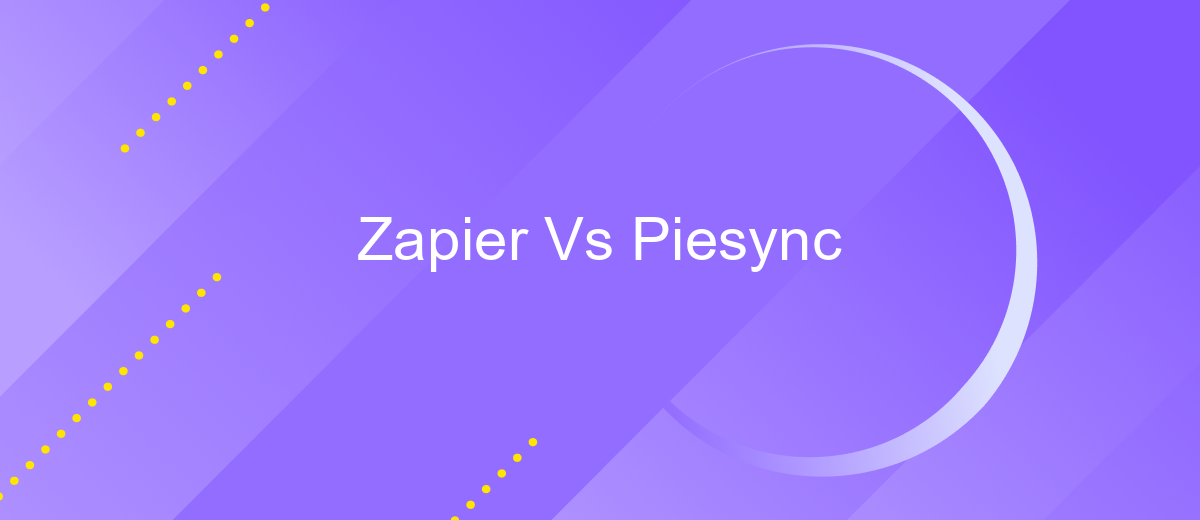Zapier Vs Piesync
In the ever-evolving landscape of digital automation, businesses are constantly seeking tools to streamline their workflows and enhance productivity. Two prominent contenders in this space are Zapier and PieSync. While both offer unique features and integrations, choosing the right tool can significantly impact your efficiency. This article delves into a detailed comparison of Zapier and PieSync, helping you make an informed decision.
Comparison Overview
When comparing Zapier and Piesync, it's important to consider their unique features and capabilities. Both platforms excel at automating workflows and integrating various apps, but they cater to slightly different needs and user preferences.
- Zapier: Focuses on task automation with a wide range of app integrations, offering a user-friendly interface and extensive documentation.
- Piesync: Specializes in real-time, two-way sync between apps, making it ideal for maintaining up-to-date data across platforms.
- ApiX-Drive: Provides a versatile solution for setting up integrations, supporting both one-way and two-way data transfers, and offers an intuitive setup process.
Ultimately, the choice between Zapier and Piesync will depend on your specific needs. If you require extensive app integrations and task automation, Zapier is likely the better fit. For those needing real-time synchronization across platforms, Piesync is the preferred option. ApiX-Drive stands out as a flexible alternative, capable of handling various integration scenarios with ease.
Feature Comparison

Zapier and Piesync both offer robust integration capabilities, but they cater to different needs. Zapier excels in providing a wide range of automation options, supporting over 3,000 apps. It allows users to create complex workflows with multiple steps and conditions. On the other hand, Piesync focuses on two-way data synchronization between apps, ensuring that information is consistently updated across platforms. This makes Piesync ideal for maintaining data integrity and consistency.
When it comes to ease of use, Zapier offers a more intuitive interface with drag-and-drop functionality, making it accessible for users with varying technical skills. Piesync, while slightly more complex, provides detailed mapping options for fields and data, giving users greater control over their integrations. For those looking for an alternative, ApiX-Drive offers a balance between ease of use and advanced features, supporting a wide range of apps and providing user-friendly tools for setting up integrations. ApiX-Drive's step-by-step setup process makes it an excellent choice for users seeking a straightforward yet powerful integration solution.
Pricing Comparison

When comparing the pricing models of Zapier and PieSync, it's important to consider the unique features and benefits each platform offers. Both services provide automation and integration capabilities, but their pricing structures differ significantly, impacting the overall value for users.
- Zapier: Zapier offers a free plan with limited features and several paid plans starting at .99 per month. The higher-tier plans provide advanced features, more tasks, and priority support.
- PieSync: PieSync does not offer a free plan, but its paid plans start at per month. PieSync's pricing is based on the number of contacts synchronized, which can be more cost-effective for businesses with smaller databases.
For businesses looking to streamline their integrations without breaking the bank, ApiX-Drive is a notable alternative. ApiX-Drive offers competitive pricing and a user-friendly interface, making it easier for businesses to manage their integrations efficiently. By understanding the pricing models of Zapier, PieSync, and alternatives like ApiX-Drive, businesses can make informed decisions that best suit their needs and budget.
User Feedback Comparison

When it comes to user feedback, both Zapier and Piesync have garnered significant attention for their ease of use and robust functionality. However, opinions vary depending on specific user needs and experiences. Zapier is often praised for its extensive range of integrations and user-friendly interface, making it a popular choice among businesses of all sizes.
On the other hand, Piesync is frequently highlighted for its bi-directional sync capabilities, which ensure that data remains consistent across multiple platforms. Users appreciate this feature, especially in scenarios where real-time data accuracy is crucial.
- Zapier: Extensive range of integrations, user-friendly interface, highly customizable workflows.
- Piesync: Bi-directional sync, real-time data accuracy, seamless integration with CRM systems.
In addition to these platforms, services like ApiX-Drive are also gaining traction. ApiX-Drive offers a simplified approach to setting up integrations, making it a valuable tool for users who need to automate workflows without extensive technical knowledge. Overall, the choice between Zapier and Piesync often comes down to specific use cases and the unique requirements of the user.
Conclusion
In conclusion, both Zapier and Piesync offer robust solutions for automating workflows and integrating various applications. Zapier excels with its extensive library of apps and user-friendly interface, making it an excellent choice for businesses looking for a versatile and easy-to-use automation tool. On the other hand, Piesync shines with its real-time, two-way data synchronization, which is particularly beneficial for maintaining up-to-date information across multiple platforms.
However, it's worth considering other alternatives like ApiX-Drive, which provides a comprehensive platform for setting up integrations. ApiX-Drive stands out with its intuitive setup process and wide range of supported applications, offering a balance between ease of use and powerful functionality. Ultimately, the best choice will depend on your specific needs and the complexity of the integrations you require. By carefully evaluating the features and capabilities of each service, you can find the most suitable solution to streamline your business processes effectively.


FAQ
What are the primary differences between Zapier and Piesync?
Can both Zapier and Piesync handle real-time data updates?
Which service is better for complex multi-step workflows?
Are there alternatives to Zapier and Piesync for automation and integration?
What types of businesses benefit most from using Zapier vs. Piesync?
Time is the most valuable resource in today's business realities. By eliminating the routine from work processes, you will get more opportunities to implement the most daring plans and ideas. Choose – you can continue to waste time, money and nerves on inefficient solutions, or you can use ApiX-Drive, automating work processes and achieving results with minimal investment of money, effort and human resources.

